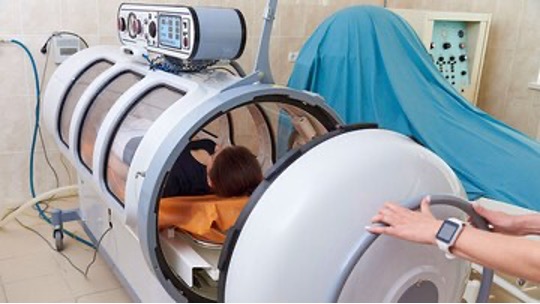Hyperbaric Oxygen May Improve Heart Function in Long COVID
May 17, 2023
Source: drugdu
 241
241

Marilynn Larkin
Editor's note: Find the latest long COVID news and guidance in Medscape's Long COVID Resource Center.
Hyperbaric oxygen therapy (HBOT) increased markers of heart function in a small randomized, controlled trial of patients with long COVID.
Patients with reduced left ventricular global longitudinal strain (GLS) at baseline who received HBOT had a significant increase in GLS compared with those who received sham treatment.
GLS is a measure of systolic function that is thought to be a predictor of heart failure-related outcomes.
The study also showed that global work efficiency (GWE) and the global work index (GWI) increased in HBOT-treated patients, though not significantly.
"HBOT is an effective treatment for diabetic foot ulcers, decompression sickness in divers, and other conditions, such as cognitive impairment after stroke," Marina Leitman, MD, of the Sackler School of Medicine, Tel Aviv, Israel, told theheart.org | Medscape Cardiology. Her team also studied HBOT in asymptomatic older patients and found that the treatment seemed to improve left ventricular end systolic function.
"We should open our minds to thinking about this treatment for another indication," she said. "That is the basis of precision medicine. We have this treatment and know it can be effective for cardiac pathology.
"Now we can say that post-COVID syndrome patients probably should be evaluated with echocardiography and GLS, which is the main parameter that showed improvement in our study," she added. "If GLS is below normal values, these patients can benefit from HBOT, although additional research is needed to determine the optimal number of sessions."
Leitman presented the study May 10 at the European Association of Cardiovascular Imaging (EACVI) 2023, a scientific congress of the European Society of Cardiology.
Biomarker Changes
The study enrolled 60 hospitalized and nonhospitalized post-COVID syndrome patients with ongoing symptoms for at least 3 months after having mild-to-moderate symptomatic COVID-19.
Participants were randomized to receive HBOT or a sham procedure five times per week for 8 weeks, for a total of 40 sessions. They underwent echocardiography at baseline and 1 to 3 weeks after the final session to assess GLS.
The HBOT group received 100% oxygen through a mask at a pressure of 2 atmospheres for 90 minutes, with 5-minute air breaks every 20 minutes.
The sham group received 21% oxygen by mask at 1 atmosphere for 90 minutes.
At baseline, 29 participants (48%) had reduced GLS, despite having a normal ejection fraction, Leitman said. Of those, 16 (53%) were in the HBOT group and 13 (43%) were in the sham group.
The average GLS at baseline across all participants was –17.8%; a normal value is about –20%.
In the HBOT group, GLS increased significantly from –17.8% at baseline to –20.2% after HBOT. In the sham group, GLS was –17.8% at baseline and –19.1% at the end of the study, with no statistically significant difference between the two measurements.
In addition, GWE increased overall after HBOT from 96.3 to 97.1.
Leitman's poster showed GLS and myocardial work indices before and after HBOT in a 45-year-old patient. Prior to treatment, GLS was –19%; GWE was 96%; and GWI was 1833 mm Hg.
After HBOT treatment, GLS was –22%; GWE, 98%; and GWI, 1911 mm Hg.
Clinical Relevance Unclear
Scott Gorenstein, MD, associate professor in the Department of Surgery and medical director of Wound Care and Hyperbaric Medicine and NYU Langone–Long Island, New York, commented on the study for theheart.org | Medscape Cardiology.
"The approach certainly warrants studying, but the benefit is difficult to assess," he said. "We still don't understand the mechanism of long COVID, so it's difficult to go from there to say that HBOT will be an effective therapy."
That said, he added, "This is probably the best study I've seen in that it's a randomized controlled trial, rather than a case series."
Nevertheless, he noted, "We have no idea from this study whether the change in GLS is clinically relevant. As a clinician, I can't now say that HBOT is going to improve heart failure secondary to long COVID. We don't know whether the participants were New York heart failure class 3 or 4, for example, and all of a sudden went from really sick to really good."
"There are many interventions that may change markers of cardiac function or inflammation," he said. "But if they don't make a difference in quantity or quality of life, is the treatment really valuable?"
Gorenstein said he would have no problem treating a patient with mild-to-moderate COVID-related heart failure with HBOT, since his own team's study conducted near the outset of the pandemic showed it was safe. "But HBOT is an expensive treatment in the US and there still are some risks and side effects, albeit very, very low."
The study received no funding. Leitman and Gorenstein have disclosed no relevant financial relationships.
European Association of Cardiovascular Imaging (EACVI) 2023. Presented May 10, 2023.
Read more on
- Multiple batches of quadrivalent influenza virus split vaccine have been sub-packaged and submitted for lot release approval; expected to be released to the market soon after approval December 12, 2025
- Ab&B Bio-Tech CO., LTD. JS Lyophilized Human Rabies Vaccine Initiates Phase III Clinical Trials December 12, 2025
- The ‘Sweetest’ HPV Vaccine Market is Gone | Haibin Interview December 12, 2025
- InnoCare Pharma announced that its first independently developed next-generation TRK inhibitor, zoletrazinib, has been approved for marketing in China December 12, 2025
- Is PD-1/VEGF dual antibody + ADC becoming the standard configuration? December 12, 2025
your submission has already been received.
OK
Subscribe
Please enter a valid Email address!
Submit
The most relevant industry news & insight will be sent to you every two weeks.



